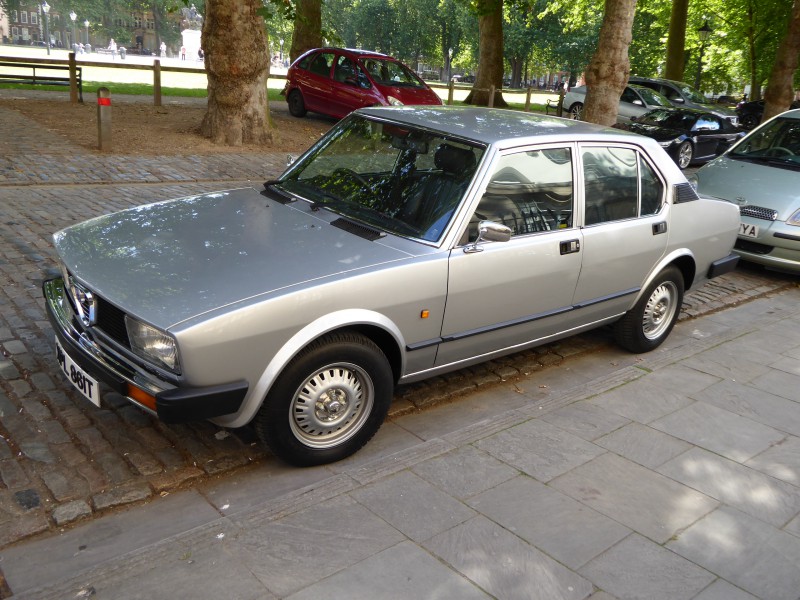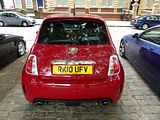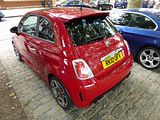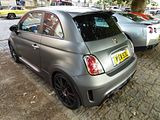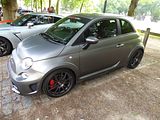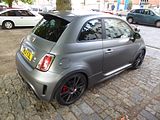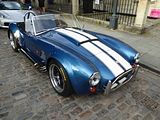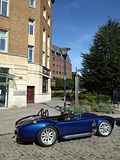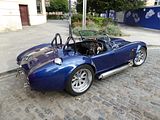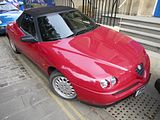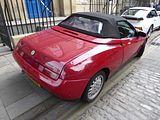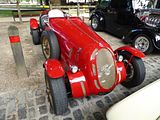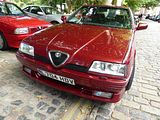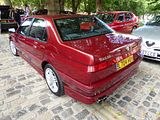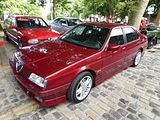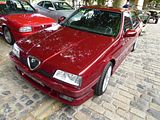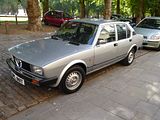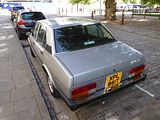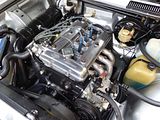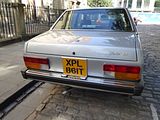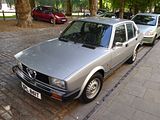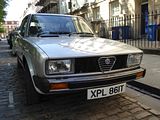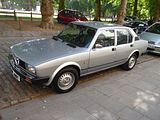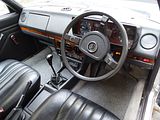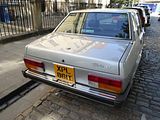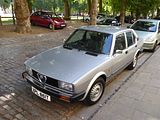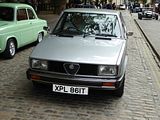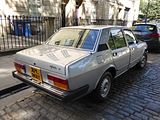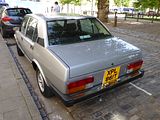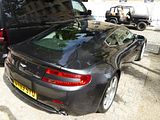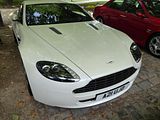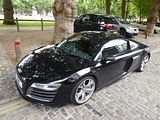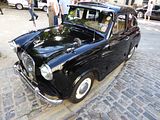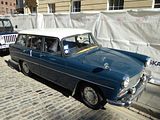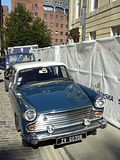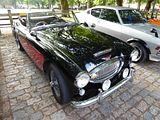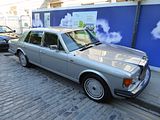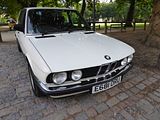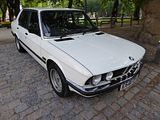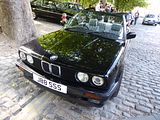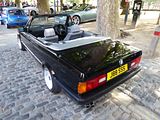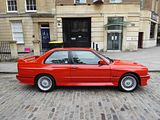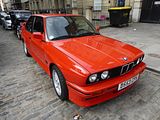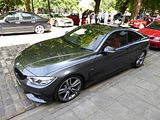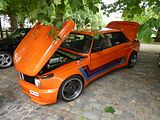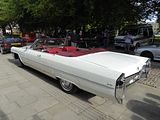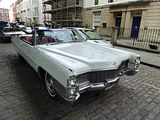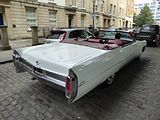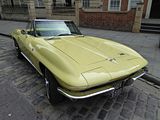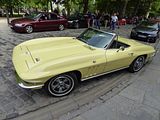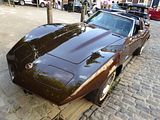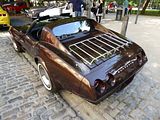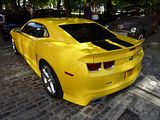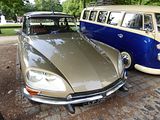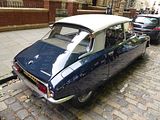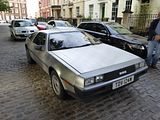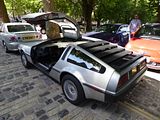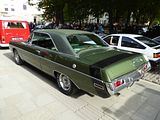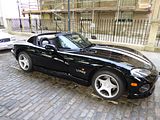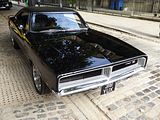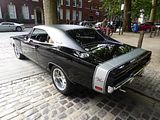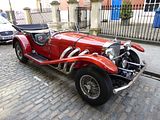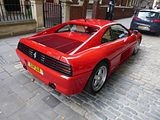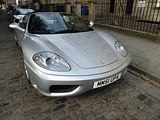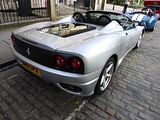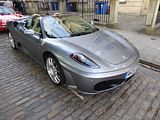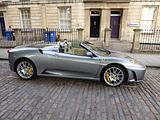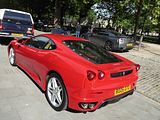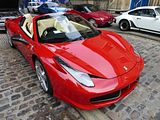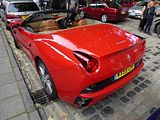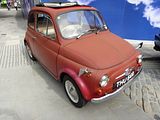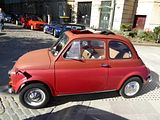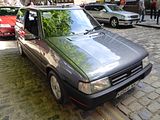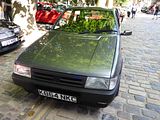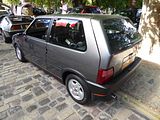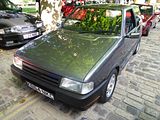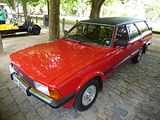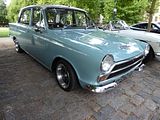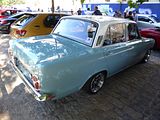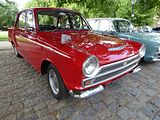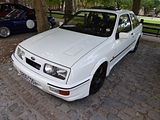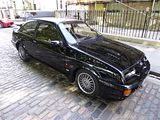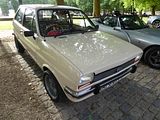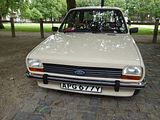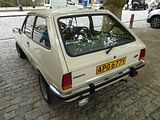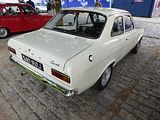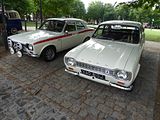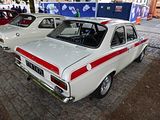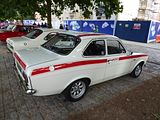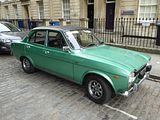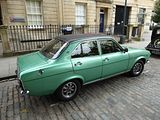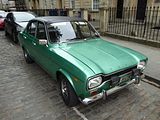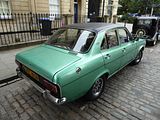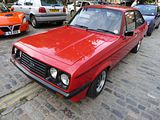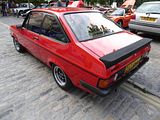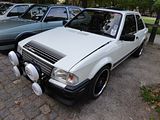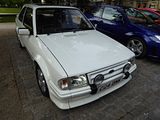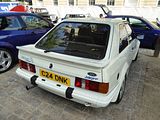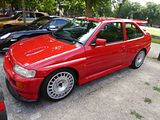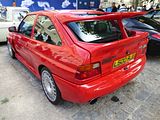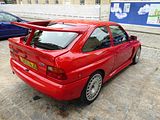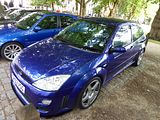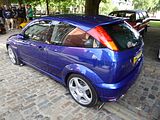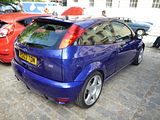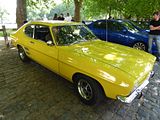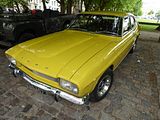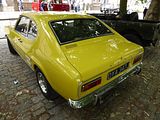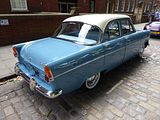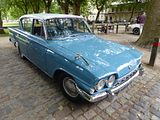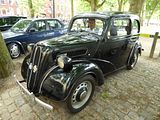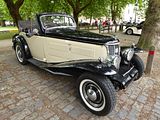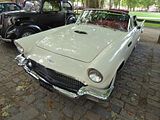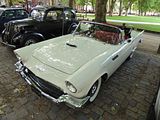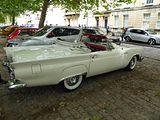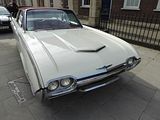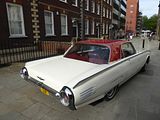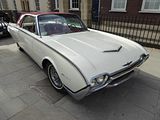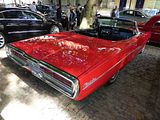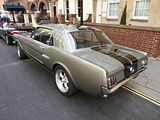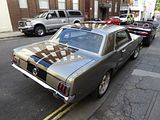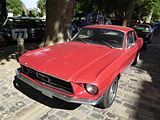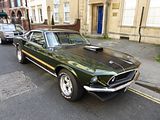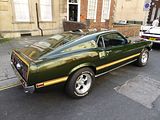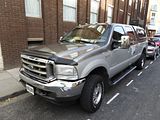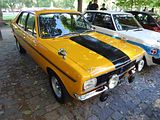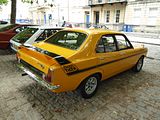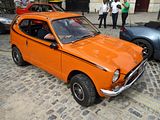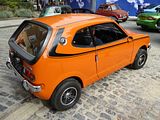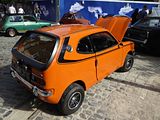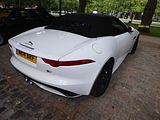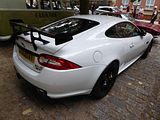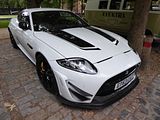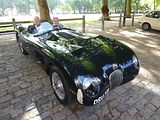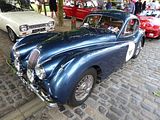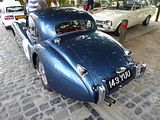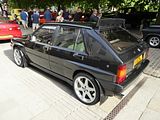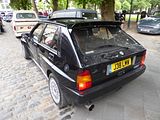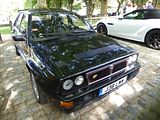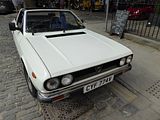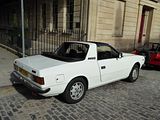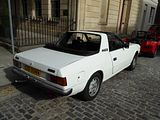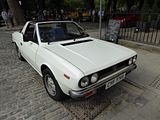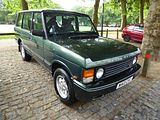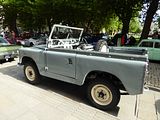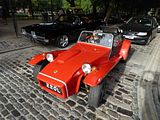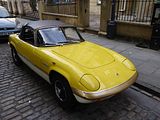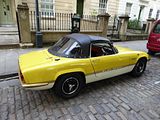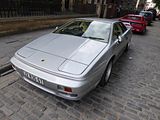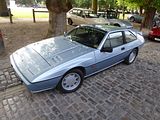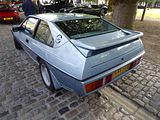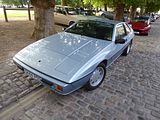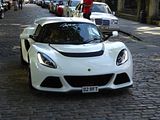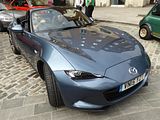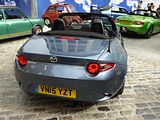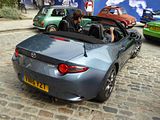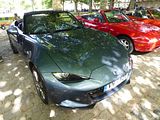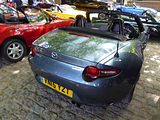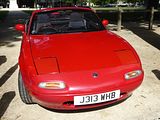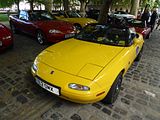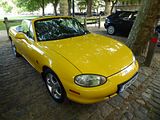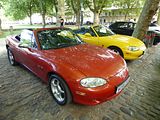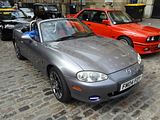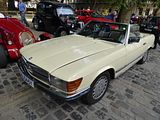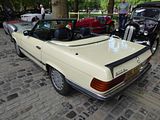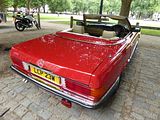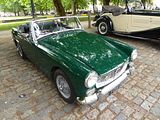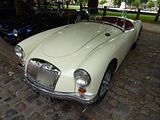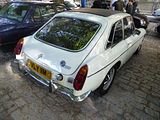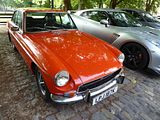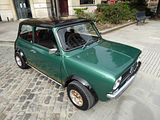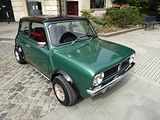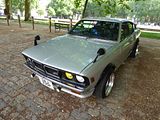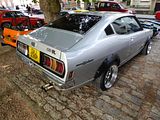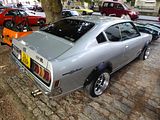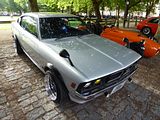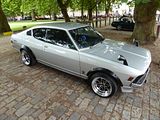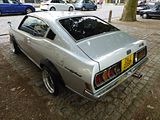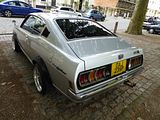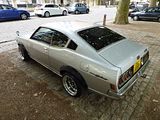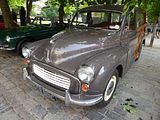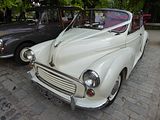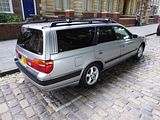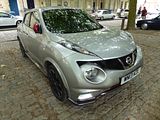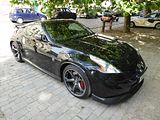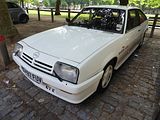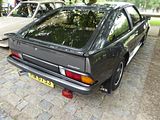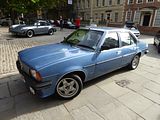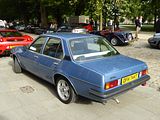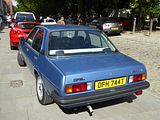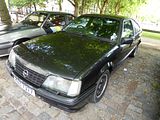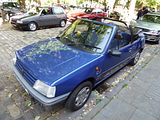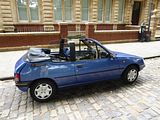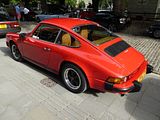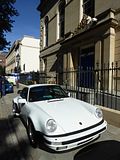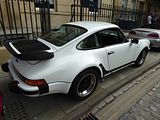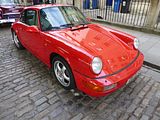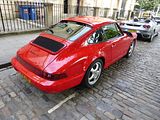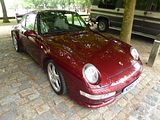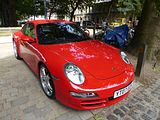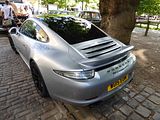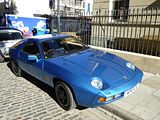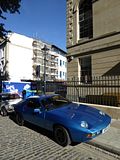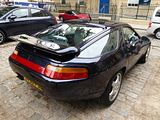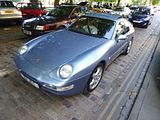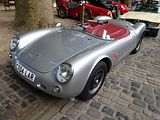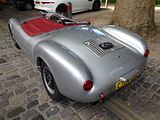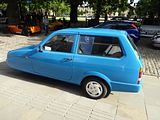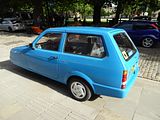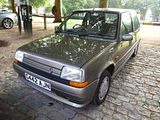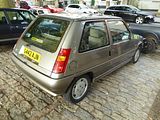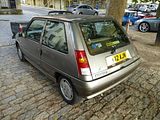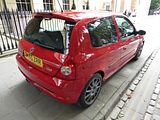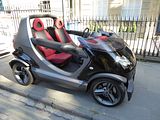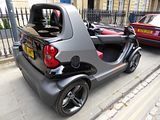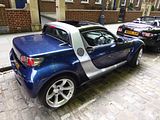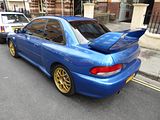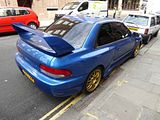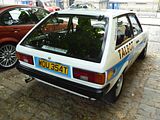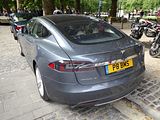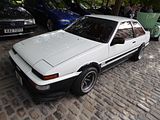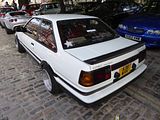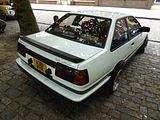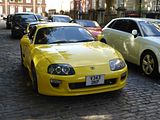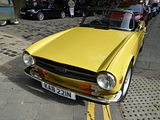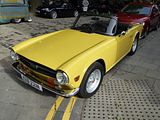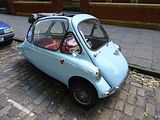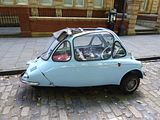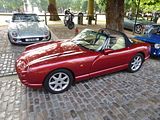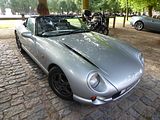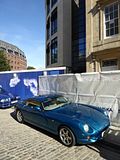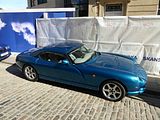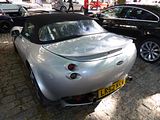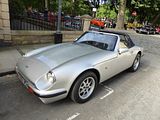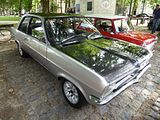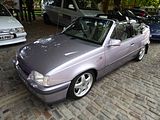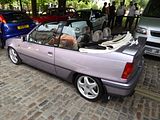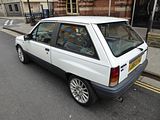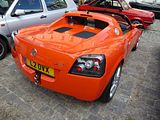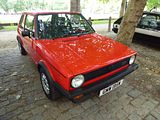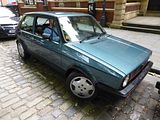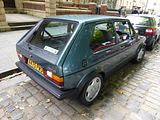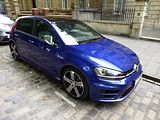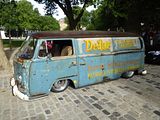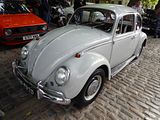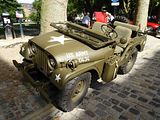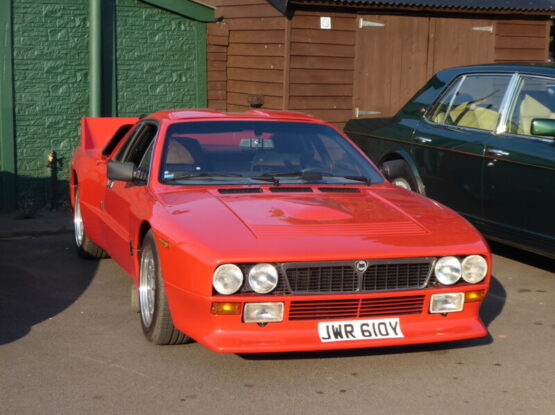The Queen Square Breakfast Club meeting takes place on the second Sunday of the month, every month, year round, in the historic part of the city in which I (some would say “allegedly”) live. It takes me less than 15 minutes to get to it, and it is always worth attending, as there are plenty of cars that you have not seen there as well as more than a few that you have. Such is the range of motoring events available during the summer months, that I’ve been attracted beyond the city limits every month since April. As the weather gradually improved, earlier in the year, so attendance at this event had rocketed. In March, an arrival at around 8:15am found an almost packed-out Square, and so I did what everyone else did in April, and arrived that bit earlier, just to try to ensure that there would be somewhere to park. Things really became challenging in May, I understand, when the event coincided with a Food Fair taking place in the centre of the Square, but by July, when the British summer weather was at its most unhelpful, the event was much quieter, proving that as ever, there is an element of random about the event, which is all part of its appeal. When I spotted an otherwise empty weekend in my busy diary, and felt the need to catch up with things domestic at home, and some sleep (!), as soon as I realised that there was also to be a Queen Square event on, I knew that I was going to find a car event to go to after all. And I am glad I did, as this turned out to be a well attended event, without being so crowded that there was a risk of someone calling in the traffic wardens again, and there were several cars that I had not seen before, to add to the enjoyment.
ABARTH
It is not uncommon for my Abarth to be the only one present at this event, and as such it attracts attention in the way that the Scorpion badged cars still do, some 7 years after the relaunch of the marque.
But this time it was comprehensively outdone by a Biposto which was parked around the opposite side of the Square. Bearing Lipscombs plates, which is the dealer in Kent, this car had either travelled a long way to attend the event, or the owner had travelled a long way to the dealer to get his or her car. I did not see anyone with the car on those occasions when I was near it, to know which of these applies, or even who it belongs to. A couple of people have signed up on the Forum, coincidentally, both on the same day, saying that they have taken delivery, so I am guessing that it is one of those. Either way, it was nice finally to see one road registered and in private hands, as to date the only ones I have seen have been dealer demo cars.
AC
Sometimes you get several “Cobra” style cars at this event. This time, there was only one that my camera spotted. A modern recreation, it certainly looked and sounded the part, and it attracted plenty of attention even just when parked up.
ALFA ROMEO
Literally the first car to attract my camera, already parked up when I arrived at early o’clock was Nick Grange’s lovely 33 Cloverleaf. It is good to see that after the work that was undertaken earlier in the year, he is now able to enjoy this car and to bring along what remains the biggest selling Alfa model of all time. with almost a million of them being made between 1983 and 1995.
Parked up next to it was a 916 series GTV and elsewhere round the Square, later I was to come across the Spider version.
Despite the fact that he lives in Frome, some distance away from Queen Square, David Roots was already parked up by the time I arrived, and there were people moving on in his Alfa Special, as they always do, for a closer look, and keen to find out more about it. After some of the rather wet and cold excursions he has had in it, I would imagine that the journey to and from the event on this occasion was actually far more pleasant.
Another well known Alfa at this event and in the area is the lovely 164 Cloverleaf Q4 that belongs to Daryl Staddon. I always like seeing this car, as the lines of Pininfarina’s saloon are among the best ever penned for a car of this type, in my opinion, and you rarely see 164s at all these days, so to see one as nice as this is always a treat.
Also parked up with these Alfas was a 156 GTA, the top of the range version of the one time Car of the Year, which packed a potent 3.2 litre V6 engine under the bonnet to create a rapid alternative to a 3 Series or a C Class.
Just as the Square was starting to look quite empty, with most of the cars gone, I spotted this fabulous Alfetta Berlina driving round. Not a car I had seen before, and extremely rare, I chased after it, hoping that it would stop. Sure enough, it did, the owner attracted by the sight of one of the other rare cars still parked up. That then allowed me to talk to the person who had been driving it. He started by saying that he had owned the car since last year, buying it from well known classic Alfa specialist, Black & White Garages in Newbury, where he found it when he had gone looking at a Giulia Berlina. The latter was not quite “right”, but this one caught his eye, and as a confirmed Alfa-holic, as it was a model that his father had owned, he just had to have it. These days it lives in a dehumidified garage a lot of the time, but he does take it out when the weather is good, and yes, he is local to Bristol, so there is every chance of seeing it again. The previous owner had clearly lavished time and money on it, as not only is the car in stunning condition, but the interior had at some point been retrimmed with extensive use of leather, including on the dash and the doors and some very intricate wood inlays had been applied again not just to the obvious places on the dash, but even set into the window winders. After apologising for the fact that it was not quite so pristine under the bonnet (still looked pretty good to me!), further conversation revealed that the person I was talking to was Simon Charlesworth, whose article comparing the Alfa 2600 Spider to the Lancia Flaminia Convertible I had been reading in “Classic and Sportscar” magazine only the previous day. He did say, as indeed I had read in the article, that it had pained him to conclude that of that pair the Lancia was the better car.
ASTON MARTIN
The only Astons I recall coming across with this duo of V8 Vantage models.
AUDI
Sole notable Audi here was this R8
AUSTIN
The A30 was the Austin’s small car, launched in 1952, that competed with the Morris Minor and the low end Fords. Never quite as popular as the in-house Morris rival, it has a dedicated following nice, as a cheeky and affordable classic.
This Irish plated car was badged A60 Cambridge, which would make it the Austin version of BMC’s Farina range, but the grille was most definitely that from the Morris Oxford of the period. I can only imagine that in creating it in its current form, someone had to use whatever parts they could find. Trim being the scarcity that it is, then it has ended up as something of a hybrid of the two cars which were basically the same anyway.
AUSTIN HEALEY
There was also only one example of the Big Healey, the 3000
BENTLEY
When Rolls Royce replaced the long running Silver Shadow in the autumn of 1980 with the Silver Spirit, there was a Bentley equivalent, called Mulsanne, taking its name from the famous straight at le Mans, scene of many great Bentley moments from 50 years previously. Bentley sales had long been a fraction of those of Rolls Royce, but that was all to chance when the Mulsanne Turbo was launched in 1982, and suddenly interest in the brand took off. Bentley continued to evolve their cars, more so than Rolls Royce, with other great names being dusted off, such as Brooklands and Eight. This, however, is just a “regular” Mulsanne model.
BMW
This E28 520i is a rare survivor from the 1980s, a time when BMW sales just started to take off. The 520i had a 6 cylinder engine, whereas its rival 2 litre cars were all still endowed with just 4, which made the car smoother than its competitors. The downside was that the car came with a very meagre standard specification, and to get it to the level of equipment that you might reasonably expect for a car of this class required a considerable list of ticks on the options page of your order form.
There were two examples of the E30 3 series: a nicely presented Convertible and this lovely M3 which seems to appear at an awful lot of events in the area
There was also an example of the current 4 Series Coupe that attracted my camera.
This car has been appearing regularly at the event over the last few months, and every time, it has made further steps towards the finished article. It is only recently that it has become orange, suggesting that the previous silver paint finish was either a form of undercoat, or was an experiment and that the owner has now decided to make a bolder still statement. It is based on a BMW 2002, of course, but there is very little apart from the basic silhouette of the car that remains from that.
CADILLAC
One of the largest cars at the event was this gargantuan and very imposing 1964 de Ville Convertible, truly a “King of the Road”.
CHEVROLET
There were a pair of Corvette models here. Older of the duo was an open topped C2 generation Convertible from 1966, a car which I understand was only recently imported into the UK, and the other one was a C3 from the late 70s
Chevrolet have officially offered the current Camaro to UK buyers, only in left hand drive guise, sadly. few have been sold, which is hardly a surprise, as this a big and thirsty car with a CO2 number which proves that Americans just don’t care about this measurement. Look past that, though, and it is a fantastic machine – or so I have thought when I have driven them in the US, where they have huge appeal. This is the V8 engined SS.
Chevrolet replaced their highly successful G-Series Van in 1971 with an all new model. Following the “engine-forward” design of the competing Ford Econoline that had been launched in 1968, Chevrolet did the same thing, moving the engine forward of the driver, which necessitated a short nose and bonnet, giving the new G-Series a very different look from its predecessor. The van was constructed of a unibody style frame and employed stronger truck style hubs and brakes with dual A-Arm independent front suspension. Suspension and steering parts came from the Chevrolet/GMC C-series pickup trucks. The same design was also marketed by GMC, who used the VanDura name. Although detailed changes were made on more or less an annual basis, the same basic design then stayed in production right through to 1996. The G-Series was popular with Van conversions such as Curtis and Starcraft. In addition to the cab-chassis models, there were also factory cube vans from Chevy and GMC, called the Chevy High-Cube or Hi-Cube, and GMC MagnaVan. For 1997, the Chevrolet and GMC vans were replaced with the next-generation Chevrolet Express and GMC Savana with more aerodynamic styling, built on a stronger truck frame versus the previous generation’s unibody construction.
CITROEN
There were two examples of the fabulous DS, a DS21 ie and the lower spec D Speciale
DELOREAN
The DMC12 is a real crowd puller. Always. Any car that does a lap of the Square with the gull-wing doors open has a massive advantage in the “cool” stakes, of course, and the fact that this car is still remembered for its starring role in “Back to the Future” nearly 30 years ago, rather the infamy surrounding its development and financing, speaks volumes.
DODGE
I’ve seen this 1970 Dodge Dart Swinger at the event before. The Dart was the “compact” model in the range, even though to our eyes, it looks rather larger than the Ford Cortina of the period. This generation of Dart was first seen in 1967, but it underwent annual revisions every year until 1976. For 1970, the Swinger name was applied to all the Dart two-door hardtops except in the high-line custom series. The Swinger model was available as a four- door version as well but few were actually produced. A number of other changes were made to the Dart line to avoid internal competition with Dodge’s new Challenger: the Dart convertible was discontinued along with the optional 383 cu in, 6.3 litre V8, leaving the 275 bhp 340 4-barrel V8 as the top Dart engine. The performance model in the Dart line for 1970 was the Swinger 340 2-door hardtop. The 1970 Swinger 340 came with functional hood scoops with 340 emblems. Standard equipment included front disc brakes, heavy duty “Rallye” suspension, a 3.23:1 rear axle ratio, fibreglass-belted bias-ply tyres mounted on 14″ × 5½” steel wheels, and a bumble bee stripe. Optional equipment included an upgrade over the standard bench seat with all-vinyl bucket seats, with which a centre console could be ordered. A performance bonnet upgrade with scoops was painted flat black with hood tie-down pins. Mechanical options included power-assisted brakes and steering. Rallye wheels and wire wheel covers were also optional, as was a 6000 rpm tachometer and a vinyl roof covering in black or white.
No doubting the speed potential of the third Dodge model here. The Viper features a thumping great 8.2 litre V10 engine under the bonnet, and whilst a bit crude in some of its dynamics, is a blisteringly fast car in the hands of the brave.
This Charger R/T is also an event regular. One of the “muscle cars” of the late 1960s and early 1970s, the Charger had first been seen in mid 1966, as Dodge’s answer to the Rambler Marlin and Ford Mustang. Based on the Coronet, there was huge demand for personal two door sporty cars like this, and sales were strong. That led to Dodge introducing a new version in 1968, when the entire B-body lineup in the range was redesigned. The Charger moved further away from the Coronet models thanks to its new styling, which featured a double-diamond coke bottle profile with curves around the front bumpers and rear quarter panels. The rear end featured a “kick up” spoiler appearance, inspired by Group 7 racing vehicles. On the roof, a “flying buttress” was added to give the rear window area a look similar to that of the 1966-67 Pontiac GTO. The Charger retained its full-width hidden headlight grille, but a vacuum operated cover replaced the electric motor rotating headlights. The previous full-width taillights were replaced with dual circular units at the direction of Styling Vice President, Elwood P. Engel. Dual scallops were added to the doors and hood. Inside, the interior was new with a conventional fixed rear seat replacing the folding bucket seat design. The conventional boot area included a vinyl mat, rather than the previous model’s carpeted cargo area. The centre console in the front remained, but there was no centre armrest. The tachometer was now optional instead of standard and the electroluminescent gauges disappeared in favour of a conventional design. The standard engine was the 318 cu in, 5.2 litre 2-bbl V8, until it was replaced in mid-year with a 225 cu in 3.7 litre slant-six. The 383-2 and 383-4 remained unchanged. A new high-performance package was added, the R/T (“Road/Track” with no ‘and’ between Road and Track). The R/T came standard with the previous year’s 440 “Magnum” and the 426 Hemi was optional. In 1968, the Chrysler Corporation began an ad campaign featuring a cartoon bee with an engine on its back featuring models called the “Scat Pack”. The Coronet R/T, Super Bee, Dart GTS, and Charger R/T received bumble-bee stripes (two thin stripes framing two thick stripes). The stripes were standard on the R/Ts and came in red, white, or black, but could be deleted at no extra cost. The 1968 model year Charger sales increased to 96,100, including over 17,000 Charger R/Ts. The car was little changed for model years 1969 and 1970 before an all new third generation car premiered for 1971.
EXCALIBUR
I knew that this retro-styled car, with looks not unlike the 1928 Mercedes-Benz SSK was an Excalibur, but it was only when researching its history, that I discovered that the origins of the car go back further than I had realised, and the instigator was the struggling Studebaker company. Back in 1963, renowned stylist Raymond Loewy had just completed his styling work on the Avanti, and the car had caused a sensation when launched. This led the President of Studebaker, one Sherwood Egbert to decide that the way to draw attention to his struggling marque was to initiate some more special automobile projects; for exhibiting at the various motor shows to be held over the forthcoming year. Loewy was not available so the young Brooks Stevens got the job and the outcome of this was a trio of Studebaker Larks, a black and pink convertible known as “Mademoiselle”, a vehicle called “Yachtman”, and a “Town Car” featuring central roll-over hoop and a vinyl half-roof. Stevens also dressed up a Hawk Gran Turismo for the display but not one of these cars made any worthwhile impression at the Chicago Motor Show at the start of the season. The next show was to be the New York in April and for this one it was imperative that he find something a little more explosive, to attract people to the stand. Without a real eye-catcher they would likely walk straight past and not even glance in the right direction. Stevens decided to create something very different, and requested a Daytona chassis- the best chassis around at the time, and one which boasted special suspension. Its front axle was overloaded in the original design but Stevens figured that if he could find a way of moving the engine backwards to a certain extent then the assembly would become better balanced. In creating his design, Stevens tool a great deal of inspiration from the Mercedes SSK. as he loved Mercedes cars and personally owned a 1928 SS Phaeton. His idea was to create a vehicle along similar lines, using contemporary running gear and selling for a very competitive price. At the time, the idea of a “contemporary classic”, or a “new old car”. was unknown, but Stevens was given the freedom to proceed with his ideas. The chassis that Stevens received at Milwaukee was from a heavy-duty Studebaker Lark Daytona convertible, with 109 inch wheelbase, assisted disc brakes and the supercharged 289 cu in. (4,750 cc) 290 hp power unit used by Studebaker up until the advent of the Avanti. Although the chassis had nothing particularly modern or innovative about it, it was well suited to the narrow bodywork of the vintage roadster-style car that Stevens had in mind. The engine was moved back by about 29 inches, which put the driver almost in the back seat of the Lark Coupe, so it was also necessary to move the steering and pedals back and modify the suspension geometry and spring and damper rates at the same time. The flexible exhaust sections had been bought in Germany from Mercedes’s own supplier, the seats were modified Studebaker items, the dashboard instruments were from the Hawk GT and the radiator grille emblem was the famous cross in a circle which Brooks had used on his first competition Excalibur Js. It was christened “Mercebaker” because Studebaker had been a Mercedes distributor for some time, although the chromed badges at either side if the hood/bonnet read Studebaker SS. Built in six weeks with the help of friends and family, the result was a sensation. But, the new automobile had hardly left Milwaukee for New York when Studebaker changed their plans Three days before the show opened, Stevens received a phone call from the Director of Public Relations and was told that Studebaker could not display the car. The reason why was that the new boss, a Mr Burlingame had said that they could not make the public think this would be the sort of vehicle they would be manufacturing in the future, even if it was made clear that it’s only a show car, it being risky to show the public a one-of exhibit that’s would never be mass-produced. Stevens phoned Jerry Allen, the Show organizer and was told to bring the car along anyhow. It ended up on a stand on the second floor, right in front of a hot dog stall (which helped get the visitors in) and the Mercebaker was unloaded from the transporter. As it was wheeled in, people made Stevens stop every ten yards or so in order to shoot photos. It was too late to remove the ‘Studebaker SS’ badges so it was clearly labelled as a “Special Project’ of Brooks Stevens Design Associates’. It was the star of the show and so many people wanted to buy it, cash, there and then. The designer and his two sons were inundated with enquiries. People kept asking the price and the unashamed answer was “6,000 dollars”, thereby acknowledging the six weeks spent building it and dreaming that $1,000 a week would be a tidy future income. As well as being the show organiser, Jerry Allen was also a Chevrolet concessionaire in the Big Apple, and Stevens managed to convince him to be the sole concessionaire for the East Coast. Twelve firm orders had been taken at the Show, and Allen sold the first cars like the proverbial hot cakes as he had an absolutely prime location in New York, including a sumptuous showroom right next to the Coliseum. But, he was also rather worried about something which eventually caused the first modification to be carried out to our car. The problem was the Studebaker chassis, as he realised that he could not sell cars powered by Studebaker engines from a showroom that’s on the ground floor of a General Motors building. He feared that one a director would stop off, out of curiosity and find out that it had a rival marque’s underpinnings, so he asked Stevens if he could put a Chevrolet engine in it, which is what was done, so the first Excalibur is the only one with a Studebaker engine; all subsequent machines received Chevrolet power. News of the car spread, with favourable articles in the US automotive press, which led to the foundation of the Excalibur company. Now all they had to do was build cars. The Stevens decided firstly that the cars would be built slowly and with the greatest care and attention, and that they would manufacture as many components as possible themselves to avoid dependence on outside suppliers. It was decided to use the Chevrolet V-8 327 cu. inch 300 hp Corvette engine, which could be optioned with a Paxton supercharger producing 435 hp which was remarkable for a 2100 lb car. They would make the body panels from glass fibre rather than aluminium, whilst the radiator grilles would be aluminium castings rather than copper as on the prototype. In the first year of production the chassis were transported by truck to Milwaukee, where the bodywork was fabricated and the Excaliburs were assembled. In January 1966 the firm moved to the West Allis Industrial zone. The Excalibur S1 was initially available only in a two-seater Roadster version (without doors and cycle fenders) as designed by Brooks Stevens. But by mid 1966 the company had built 56 automobiles and introduced two more models: an elaborated Roadster with longer mudguards and running boards (with doors), and a convertible four-seater (with doors) known as the Phaeton. Excalibur built exactly 90 cars during 1966 and production didn’t reach 100 units in a year until 1969 – the same year that S1 production was stopped. By 1970, Excalibur were well established but their success had engendered the birth of numerous imitators who were helping satisfy the demands of a market that the limited Excalibur production alone could not. The Stevens brothers didn’t want to increase their production rate for fear it would adversely affect the impeccable build quality that they wanted the public to enjoy. So they launched the Excalibur Series II, an all new car despite the fact that it perpetuated the S1 styling. As the old Studebaker Lark chassis was no longer built, the S2 featured a new ladder chassis which had a two inch longer wheelbase. The suspension components were borrowed from the Corvette, as was the four-disc braking system. Tyre size went up and the rubbers were mounted on wheels especially designed for the car. The 327 ci. inch (5400 cc) V-8 engine bowed down to the new 350 cu. inch (5700 cc) unit which, with its anti-pollution equipment still managed to develop a healthy 300 hp. The “Muncie” four-speed manual transmission became standard, with a Turbo-Hydramatic three-speed unit available as an option. From a price of $6000-$7250 for the S1, the Excalibur SII went up to $12,000 -$13,000 but justified that extra cost with its supplementary equipment, which included air conditioning, variable ratio power steering, adjustable steering column, servoed brakes, “Positraction” differential, chromed wire wheels, stereo radio, two spare tyres mounted in the front fenders, driving lamps, air horns and constant level rear shock absorbers. Despite the added mass of this luxurious equipment, the Excalibur Series II was capable of really sporting performance: 0-60 mph in under 7 seconds and a top speed of 149 mph! Unfortunately the production figures showed a steep decline at first with only 37 cars in 1970 and none whatsoever in 1971, but then the figure rose to 122 in 1972. Even so, the Excalibur Series II remains the rarest of all Excaliburs, with a total production number of only 342 against the Series I’s 359. It was the Excalibur Series III, introduced in 1975, that really caused the production figures to shoot up and the selling price also. This was fundamentally a Series II car that had been modified to conform with new homologation requirements and thus it retained the traditional style but featured more enveloping wings. The chassis was a new one, although still a ladder-type affair, reinforced by a central ‘X’-shaped member and featuring a removable bolt-on front section. the wheelbase had once more been stretched to 112 inches and the whole new chassis assembly housed an equally new engine…a Chevy Mk IV 454 cu. inch (7500 cc) big-block V8 which, despite its generous cylinder capacity, produced only a humble 215 hp SAE due to the stifling anti-pollution equipment fitted. The “Phaeton” version continued to sell in greater numbers than the “Roadster”, as had indeed been the case since 1969, and even though production did remain restricted (even by a specialist manufacturer’s standards) Excalibur broke a new sales record in 1977 with 237 units, followed by an encouraging increase of from 263 cars in 1978 to 367 in 1979. This impressive figure related to a production rate of more than one automobile per working day and at this rate, the firm struggled to maintain the standards of build quality that they wanted, which led to them scaling production back to 4.5 cars per week. 1980 saw the arrival of the Excalibur Series IV, the car that brought about the first real change in appearance of the marque’s products. It was also the first Excalibur to have glass side windows, a boot integrated within the bodywork and an electrically operated soft-top for Roadster as well as Phaeton models. The chassis, especially unchanged relative to the SIII’s, was stretched again, this time by 13 inches; and the Roadster became a four-seater with rear electrically operated rumble-seat. The styling had also evolved a little. It still undeniably evoked vintage Mercedes, but this time emulated the 500/540K series rather than the SS/SSK. The series IV was obliged (by even more rigorous anti-pollution regulators) to take on yet another engine, a GM 5.0-litre (305 cu. in.) equipped with automatic transmission and a locking torque converter. Once more the performance suffered, although the buying public seemed to be resigned to this and appeared more concerned with comfort and appointments than out-and-out dynamics. With the galloping inflation of the early 80s, though, Excalibur were building seven cars a week but not showing any profits for it. They decided to try to increase the price a lot, justified by increasing the spec, so the Series IV equipment comprised electric windows, central locking, cruise control, electrically operated front seats, Blaupunkt AM/FM stereo radio/cassettes and a removable hardtop. To celebrate its 20th birthday, Excalibur built a limited edition Series IV of which 50 examples were built. Painted white and grey, these cars have a chromed waistline trim strip which separates the two colours, a small plaque bearing the Stevens brother’s signatures, and the Series number of the car. The interior is harmonized with the bodywork colours and these are the first Excalibur models to be trimmed with Connolly hide. In order to respect the tradition of changing models every five years, Excalibur introduced its Series V in 1985, a yet more luxurious vehicle offering a choice of more powerful engines for the European market, the most potent one developing over 300 hp SAE. They only managed to sell 97 cars in that year and 68 in 1986, although four Excalibur Royales were also completed as well as the new fixed-head coupe- the first (and last) fixed roof Excalibur (Limited, not to be confused with the later Limited 100). With the bigger and heavier Excalibur performing below customers’ expectations, plus the start of a severe recession and lofty new inflation-fuelled prices—now near $40,000—Excalibur sales nosedived. The Stevens family also faced burdensome new overhead costs from a heavy revamping of their suburban Milwaukee plant to improve quality. The result was a steadily worsening situation that forced the brothers to file for Chapter 11 bankruptcy in mid-1986. Help came in the form of Henry Warner, president of Acquisition Company of Wisconsin, who bought the Stevens family’s interests and reorganized the firm as Excalibur Marketing Corporation. By early 1987, Series IV roadsters and phaetons were again trickling out of Milwaukee as Series V models. Their main difference was a more-potent 350 Chevy V-8 option that partly redressed the weak performance of the standard 305. At midyear, EMC revealed a whopping four-door Touring Sedan on a 144-inch-wheelbase chassis (essentially a 20-inch stretch of the phaeton’s square-tube ladder frame). Measuring 224 inches long and weighing 4400 pounds, the Touring Sedan was optimistically priced at the same $65,650 figure applied to both open Series Vs, with which it shared frontal styling. Interiors were opulent. A front bench replaced the phaeton’s buckets, and the long wheelbase made for a rear compartment worthy of a ’30s Cadillac Sixteen. Also announced was an even-more-extravagant 204-inch-wheelbase “grand limousine.” But none of this served to boost sales and thus did not attract needed capital to offset mounting debts in an economy again gone slack. Nor did a three-year, $9-million lease deal with a Chicago concern involving some 150 cars. As a result, Excalibur went bankrupt again, production ceasing in June 1990. But Excalibur wasn’t quite dead. In November 1991, German Michael Timmer bought the firm for $1.33 million amid charges that the Warner regime engaged in odometer fraud, installed some used parts, failed to meet federal passive-restraint rules, and generally did its best to “kill” the company. Timmer seemed bent on saving it, putting $1 million toward plant improvements with an eye to resuming production by April 1992. There would be four models: Series V roadster, phaeton and sedan, plus, surprisingly, a revived Series III roadster. Prices were targeted for the $50,000-$75,000 range. Unfortunately, Timmer ran out of money before he could build any cars, so Excalibur was again bankrupt by early ’92. But it was still alive, thanks to a new rescue by the German father-and-son team of Udo and Jens Geitlinger, who’d made a fortune in real estate. With help from production boss Scott Dennison and some 33 other employees still hanging on from prior regimes, Jens picked up where Timmer left off, issuing an updated Series III roadster called the “Limited Edition 100.” Besides design changes for all the latest safety and emissions standards, including a driver-side air bag, the Geitlinger Series III carried the new 300-bhp Corvette LT1 V-8 teamed with a four-speed automatic or optional six-speed ZF manual. Price was set at $89,842. At the same time, the big limo was to get a new dash and GM suspension to sell for a staggering $124,774. The other Series V cars weren’t forgotten, being muscled up to L98 Corvette power and starting prices of $74,986 for the roadster and $77,691 for the phaeton. The Geitlingers eyed total first-year production of 60-80 units, and Dennison predicted 120 Excaliburs per year starting in 1993, with some two-thirds earmarked for export. But the world market had also changed dramatically, and Excalibur could no longer do business as usual. Accordingly, the firm diversified in 1993, first by adding a replica Shelby-Cobra with some interesting deviations from the original, then by becoming a contract supplier of various “accessories” like luggage racks and “aero” cab extensions for trucks. Motorcycle trailers were also built. Car production ended in 1997, but accessory production continued until the early 2000s when Excalibur once again went into receivership. In 2003, Alice Preston of Camelot Classic Cars Inc., Milwaukee, Wisconsin,who had worked with Brooks Stevens since 1963, purchased the assets of Excalibur Automobile Corp. The company continues selling parts and performing restorations and repairs on the 3500 Excaliburs produced and there are hopes someday to resume auto production using its former body styles.
FERRARI
All the Ferrari cars here were V8s. Several of them are event regulars, such as this immaculately presented 348tb.
Next completely new body style was the 360 Modena of 1999 and there were examples of the open topped Spider version of this car and the later F430 as well as a Coupe version of the F430.
From the current range were a 458 Spider and at least one California. There’s only one photo of the latter in my album, but I am sure that I did see at least another one – also red – driving around the Square during the morning.
FIAT
There were two examples of the lovable Nuova 500 here, and these are adorable little classics, without doubt.
There are quite a lot of 500s around on British roads, many having been brought in from Italy in recent years, but the other Fiat here is far rarer, a Uno Turbo. Launched in 1985, at a time, when every manufacturer was rushing to bolt a turbo on to as many models as they could, to create instant performance machines, the Uno Turbo was a rival to the Fiesta XR2, the Peugeot 205 GTi and the Renault R5 GT Turbo which would appear a few months later. It found its own following, though it never achieved the cult of the Peugeot and there are far fewer of them left. Just 21 of them are registered for the UK at present (there are quite a few more on SORN).
FORD
There were lots of Fords, of course. Although there was an emphasis on the sporting models, unsurprisingly, it was some of the others which proved just as interesting, and certainly rarer. That is definitely the case if you consider the Cortina. For many years, this was Britain’s best seller, regularly capturing in excess of 10% of the market, which seems an incredible achievement for a single model these days, but of course there were far fewer different models available in the 1960s and 1970s when this car was in its heyday. Perversely, it is the oldest cars that you see most often, with the most recent ones being the rarest, and of those, the Estate cars are far less common than the Saloon, so that makes this 2.0 Ghia Estate, from the generation that many call the Cortina Mark V, and which Ford called the Cortina 80, a particularly rare spot.
The other Cortina models here were Mark 1 cars, parked up alongside each other. Both were the GT model, a sporting top of the range, which was launched in the Spring of 1963, a few months after the more basic cars. It had a revised version of the pre-cross-flow 1500cc engine which generated 78 bhp, thanks to a revised breathing and a twin choke carburettor. It also had revisions to the suspension, and was noticeably brisker than the standard 60 bhp 1500cc car.
Replacement for the Cortina was the Sierra, Ford’s so-called “jelly mould” that has not really found the same level of favour of interest among enthusiast, except for the Cosworth models. First shown in 1986, the RS Cosworth was based on the three door model, and had genuine supercar level performance at a price that many could afford (until the insurance premiums rocketed, thanks to the appeal that the car had with the criminal fraternity!). There was a nice example of this and the later limited production RS500 model here.
There were two very different examples of the Fiesta. Both would now count as rare. The older of the two was simply one of the regular little hatchbacks, in its first and now incredibly basic looking guise. Save for a set of rather wider wheels, which probably make it less skittish to drive, this was a pretty original looking version of a car that we once saw every day in huge quantity. Also present was the RS Turbo version of the second style of Fiesta. This was produced to answer the challenge set by those who wanted more performance than the XR2i could offer, and combined a Turbo with the 1800cc Zetec engine to put out 130 bhp. It proved relatively short-lived, though, as the model was not replaced when the Fiesta range was updated in 1995.
There were lots of Escort models. Three of them were Mark 1 cars, and these were probably the ones that were generating the most interest. Parked next to each other were a Twin Cam and a Mexico. The former is particularly rare. Looking relatively innocuous, this car packs a real punch under the bonnet. Built for Group 2 international rallying. it had an engine with a Lotus-made eight-valve twin camshaft head fitted to the 1.5 litre non-crossflow block, with a bigger bore than usual to give a capacity of 1,557 cc. This engine had originally been developed for the Lotus Elan. Production of the Twin Cam, which was originally produced at Halewood, was phased out as the Cosworth-engined RS1600 (RS denoting Rallye Sport) production began. The most famous edition of the Twin Cam was raced on behalf of Ford by Alan Mann Racing in the British Saloon Car Championship in 1968 and 1969, sporting a full Formula 2 Ford FVC 16-valve engine producing over 200 hp. The Escort, driven by Australian driver Frank Gardner went on to comfortably win the 1968 championship. Sitting alongside it was a Mexico, a better known and also legendary model. The Mexico is name after the Escort’s success in the 1970 London – Mexico rally, which the car won with renowned Finn Hannu Mikkola at the wheel. The Mexico and the more potent RS1600 were built at Ford’s Advanced Vehicle Operations (AVO) facility located at the Aveley Plant in South Essex. As well as higher performance engines and sports suspension, these models featured strengthened bodyshells utilising seam welding in places of spot welding, making them more suitable for competition.
Late in the Mark 1’s life, Ford tried to recreate the magic of the 1960s Cortina 1600E with an Escort equivalent, the 1300E. And they largely succeeded. Using the uprated crossflow 1300cc engine from the GT, the 1300E featured a vinyl roof, wood door cappings and upgraded trim. Most of the cars were 2 doors and were sold in a distinctive Aubergine colour, but there were 4 door models as well, and this is, I am told, a genuine 1300E colour.
There were examples of the following three generations of car to bear the Escort name, as well. For the Mark 2, it was the RS2000, which sat at the top of the range, and was clearly identified by its unique frontal styling. The front wheel drive Mark 3 model here was the short lived RS1600i and the later RS Turbo, while for the much derided fourth generation, it was an example of the RS Cosworth that was here, a car which shared little other than a name with the prosaic models.
Escort gave way to the Focus in 1998, and it was not long before a top of the range sporting car emerged, the RS. A legend when new, and still much admired now, there were a couple of these cars present.
There were a number of other interesting and older Fords here, too, including a Mark 1 Capri, a Mark 2 Consul and a event regular, a Consul Classic.
Representing the basics of motoring, 30s and 40s style were this pair, a Model Y and a “sit up and beg” E103 Popular. Sometimes called the Eight, the Model Y was the first Ford designed in Europe. It was powered by a 933 cc, 8 hp Ford sidevalve engine, and was available in two and four-door versions. The suspension was by the traditional Ford transverse leaf springs front and rear and the engine drove the rear wheels through a three-speed gearbox which, right from the start, featured synchromesh between the top two ratios. The maximum speed was just under 60 mph and fuel consumption was 32 mpg. Even by the standards of the time, the car, like its major competitor the Austin 7, was found noteworthy for its almost unbelievable lack of brakes. In June 1935 a reduced specification two-door model was the only closed-body car ever to sell in Britain for just £100, a price it held until July 1937.
It was replaced by the 7Y in 1938, which following a minor facelift became the Anglia. Production resumed after the war, along with a four door version, the Prefect. When these models were replaced by a much more modern design in 1953, the design lived on in the E103 Popular. It was powered by a Ford Sidevalve 1172 cc, 30 bhp four-cylinder engine, and was very basic. It had a single vacuum-powered wiper, no heater, vinyl trim, and very little chrome; even the bumpers were painted, and the bakelite dash of the Anglia was replaced by a flat steel panel. The Popular 103E differed visually from the Anglia E494E in having smaller headlights and a lack of trim on the side of the bonnet. Early 103Es had the three spoke banjo type Anglia/Prefect steering wheel as stocks of these were used up, but most have a two spoke wheel similar to the 100E wheel but in brown. Early Populars also had the single centrally mounted tail/stop-lamp of the Anglia, but this changed to a two tail/stop lamp set up with the lamps mounted on the mudguards and a separate number plate lamp. This car proved successful because, while on paper it was a sensible alternative to a clean, late-model used car, in practice there were no clean late-model used cars available in postwar Britain owing to the six-year halt in production caused by the Second World War. This problem was compounded by stringent export quotas that made obtaining a new car in the late 1940s and into the early 1950s difficult, and covenants forbidding new-car buyers from selling for up to three years after delivery. Unless the purchaser could pay the extra £100 or so for an Anglia 100E, Austin A30 or Morris Minor, the choice was the Popular or a pre-war car. 155,340 Populars were produced.
The Ford Pilot Model E71A was an upper-medium sized car that was built by Ford in the UK from August 1947 to 1951, at which point it was effectively replaced with the launch of Ford UK’s Zephyr Six and Consul models, though V8 Pilots were still offered for sale, being gradually withdrawn during that year. During the period of manufacture 22,155 cars were produced. The majority of Pilots were four door saloons, with a small number of Estate cars and Pickups (these last for export only), so I am guessing that this is a Special that was converted at some later stage. I’ve seen it at this event several times before.
There were three Thunderbirds here, and they showed three of the first four style of the model, with the Mark 1 of 1956 joined by cars from 1961 and 1965.
Also from Ford’s American back-catalogue were three examples of the Mark 1 Mustang, showing how the 1964 car gradually changed ever year.
Commercial vehicles were this F250 and an Econoline Van
HILLMAN
This Avenger Tiger is one of the most inveterate attendees here. Named to evoke memories of the Sunbeam Tiger, the Avenger Tiger concept began as a publicity exercise. Four door Avenger Super cars were modified by the Chrysler Competitions Centre under Des O’ Dell and the Tiger model was launched in March 1972. Modifications included the 1500 GT engine with an improved cylinder head with enlarged valves, twin Weber carburettors and a compression ratio of 9.4:1. The engine now developed 92.5 bhp at 6,100 rpm. The suspension was also uprated, whilst brakes, rear axle, and gearbox were directly from the GT. All the cars were painted in a distinctive yellow colour scheme (“Sundance”) and were readily identified by their bonnet bulge, rear spoiler and side stripes, all of which were standard. The car was set off with “Avenger Tiger” lettering on the rear quarters. Road test figures demonstrated a 0–60 mph time of 8.9 seconds and a top speed of 108 mph. These figures beat the rival Ford Escort Mexico, but fuel consumption was heavy. Even in 1972, the Tiger developed a reputation for its thirst. Production figures are vague but it is believed that around 200 of the initial Mark 1 cars were made. In October 1972, Chrysler unveiled the more “productionised” Mark 2 Tiger. This time the Avenger GL bodyshell with four round headlights was used. Mechanically identical to the earlier cars, the bonnet bulge was lost although the bonnet turned matt black, and there were changes to wheels and seats. These cars went on sale at £1,350. Production was around 400. Red (“Wardance”) was now available as well as yellow (“Sundance”), both with black detailing. The car here, therefore, is a Mark 1.
HONDA
One of the rarest cars of the day was this diminutive Honda Coupe Z. Just 8 are believed to be left in the UK, so you’re not going to see another one for a while! The two-door Honda Z debuted in October 1970 and was marketed until 1973 in most countries. Marketed as the “sport coupé” version of the N600, total production was 40,586. Like the N Series cars, the Z was available with more than one engine, both of them tiny. Most markets only got the larger capacity unit, the 598 cc twin which gave the car its Z600 name, adopted for some countries, though not the UK where it was simply called Z. A smaller-engined Honda Z360 was available in Japan and Australia, with a 354 cc twin. As with all cars in the Kei class, the Z360’s specifications were tightly governed. The Z360 originally featured an air-cooled, 354 cc, 2-cylinder SOHC engine with a 4- or 5-speed transmission driving the front wheels. Outputs were 31 hp at 8500 rpm for the Act and Pro versions, and 36 hp at an astronomical 9000 rpm for the sportier TS and GS models. The Z600 model’s 598 cc SOHC engine was rated at 36 hp. In December 1971, the Z360 received a facelift and a water-cooled engine, it too producing 36 hp at 9000 rpm. Only a month later, the 31 hp engine used in the lower spec variants (Standard, Deluxe, Automatic, Custom) also became water-cooled. The engine’s technical achievements reflected influence from Honda’s larger 1.3 litre air-cooled four cylinder used in the Honda 1300 coupe and sedan. The Z featured coil sprung and independent front suspension and leaf springs on a live beam axle rear suspension. The interior accommodated two adults, with a very small rear seat. A rear glass hatch with a black plastic surround opened to a shallow cargo area. Below the cargo area a compartment, accessible via a lid beneath the number plate, held the spare wheel and tools. Later versions, after a November 1972 facelift, deleted the extra lid and also moved the licence plate down where it had used to be. These also received the new EA engine of 356 cc, now only available in a more powerful, 36 hp version. In Europe only the Z600 was marketed, as the N360 had been considered underpowered. 918 cars were sold in Europe, most of them in France and Switzerland. A large number of these cars found their way to Germany (where it had not been marketed), where the engines were downsleeved to 242 cc in order to fit a particular “Class IV” category of driver’s licenses which did not require an exam. he engine offered from 12.5 to 14 hp and provided a top speed of 85 km/h (53 mph. )Production ended in 1974, after the new Civic had arrived and the Oil Crisis had diminished the market for “fun” cars. the chap who owns this is a real enthusiast of small Honda cars, as he said he has an S800 sports car as well. He went on to say that one of the 8 left in the UK had been at a dealer for a long time as a show car, and when they came to try to sell it, they asked for £75k. They did not get it, as the cars are interesting – but they’re not worth anything like that, even in almost unused form – yet!
JAGUAR
The F Type Convertible is, by common consent, one of the best looking cars on sale at present, and also one of the best sounding, with a particularly sonorous noise that comes from the combination of engine and exhaust system. Very lovely!
Just ten of the very special XKRS-GT models were produced in right hand drive form, and Jaguar kept three of them for their own purposes, so this is an extremely rare car.
This C Type is not one of the original cars, but a well constructed replica. Certainly looks the part, though!
I recall seeing this fabulous 1953 XK120 at the meeting last November, when it sported a discrete sign in the window proclaiming that following a fastidious restoration, it was offered for sale. There was nothing as vulgar as a price listed at the time. I am nbot sure whether it was still available, or whether its new owner was bringing it for us all to have another look.
JENSEN
The Interceptor was the replacement for the slightly awkward looking CV8 which had first been seen in 1962. After a false start when a car with the same name was shown in 1965, and which received a massive “thumbs down”, Jensen went to Italy to find a new stylist. Carozzeria Touring, and they also used an Italian firm, Vignale, to build the first bodies before they were shipped back to West Bromwich for final assembly, though later they were were made in house . As with the CV8, motive power came from a large Chrysler V8 engine, which gave the car effortless performance, and a somewhat prodigious thirst. The original specification included electric windows, reclining front seats, a wood rimmed steering wheel, radio with twin speakers, reversing lights and an electric clock. Power steering was included as standard from September 1968. The Mark II was announced in October 1969, with slightly revised styling around the headlamps, front grille and bumper and revised rear lights. The interior was substantially revised in order to meet US regulations, and air conditioning was an option. The Mark III, introduced in 1971, revised the front grille, headlamp finishers and bumper treatment again. It had GKN alloy wheels and air conditioning as standard, and revised seats. It was divided into G-, H-, and J-series depending on the production year. The 6.3 litre engine was superseded by the 7.2 litre in 1971. A Convertible version was premiered in 1974,. but just 267 were built, and then in 1975 a Coupe model was shown, effectively a fixed roof version of the Convertible, just 60 of which were made as by this time, the company had fallen on hard times due to the then world-wide recession, and massive and costly reliability problems with its Jensen-Healey sports car. It was placed into receivership and the receivers allowed production to be wrapped up using the available cache of parts. Production of the Interceptor ended in 1976. Enthusiasm for the car remained, though, so in the late 1980s, a group of investors stepped in and re-launched production of the Interceptor, as the Series 4, back as a low-volume hand built and bespoke affair, marketed in a similar way to Bristol, with a price (£70,000 and more) to match. Though the body remained essentially the same as the last of the main production run of series 3; the engine was a much smaller Chrysler supplied 5.9 litre unit which used more modern controls to reduce emissions comparatively and still produce about 230 hp. In addition, the interior was slightly re-designed with the addition of modern “sports” front seats as opposed to the armchair style of the earlier models, as well as a revised dashboard and electronics. The then owner sold up in 1990 to an engineering company believed to be in a stronger position to manufacture the car which lasted until 1993 with approximately 36 cars built, and while work commenced on development of a Series 5 Interceptor, once again receivers were called in and the company was liquidated. Even that was not quite the end of the story, as the Jensen specialist based at Cropredy Bridge has made a business out of rebuilding original Interceptors using modern components, with a General Motors supplied 6.2 litre LS3 engine and transmission from a Chevrolet Corvette. In May 2010, Jensen International Automotive was set up, with the financial backing and know-how of Carphone Warehouse founder and chairman Charles Dunstone who joined its board of directors. A small number of Jensen Interceptor Ss, which had started production under a previous company, are being completed by Jensen International Automotive (JIA), in parallel with JIA’s own production of the new Jensen Interceptor R; deliveries of the latter started at the beginning of 2011.
LANCIA
There were a couple of examples of what must be Lancia’s best known, and best loved car, the Delta Integrale. It is sad that the company that once produced such a legend has struggled not just to replace it with anything which gets even vaguely close to having the same appeal, but is now facing a sad and inglorious end after a disastrous venture seeing the brand offering a mix of rebadged Chrysler products and their own gawky Ypsilon and third generation Delta.
I don’t recall seeing this particular Beta Spider before. A 1976 addition to the Beta range, the Spyder was designed by Pininfarina but actually built by Zagato, which is why it was known as the Zagato in America. The Spyder used the Coupé’s shorter wheelbase and featured a targa top roof panel, a roll-over bar and folding rear roof.. Early models did not have a cross-member supporting the roof between the tops of the A to B pillars. Later models had fixed cross-members. It was initially powered by either the 1600 or 1800 twin-cam engine, later being replaced by the new 1.6 and 2.0. It never received the IE or VX engines. There were fuel injected engines for the US market. Lancia spelt the name with a “y” rather than an “i” possibly to differentiate the car from the Alfa Romeo Spider, though most people tend to use the “Spider” spelling these days. 9390 examples were built.
LAND ROVER
First generation Range Rovers have definitely acquired classic status now. It is the very early cars – especially the pre-production “Velar” cars – for which collectors are prepared to pay astonishing sums of money, but that is having an effect on all models. This is a late model Vogue, far more luxurious than those earlier cars.
Also seen here was a Series 2 Land-Rover, a classic as well.
LOTUS
This is a Mark IV version of the Lotus Seven. You don’t see them that often, as purists will tell you that the Mark IV is perhaps not the model’s finest hour, with its squared off styling, but it has an important place in the history of a model which started out life in 1957 and which gained a new lease of life when Lotus sold the manufacturing rights to Caterham in 1973. The Series 4 was launched at the Racing Car Show in January 1970. This was the model where Lotus radically changed the shape of their long running car, to create a slightly more conventional sized machine with a squarer fibreglass shell replacing most of the aluminium bodywork. It also offered some “luxuries” as standard, such as an internal heater matrix. It was not that well received. What is believed to be the oldest of these Series 4s survives to this day, and can be seen most weekends around Sussex and Kent. However, time has proved critics of the S4 wrong; its looks have aged better than many predicted, and its performance and reliability are unsurpassed by any of the original Sevens
The Elan Sprint was the last version of Colin Chapman’s 1962 masterpiece, sold between 1971 and 1973, and following the Series 1, 2, 3 and 4. Essentially, the Sprint was an up rated S4, fitted with a more powerful version of the Lotus twin cam engine. Though there are some who see the Sprint as a tuned S4, there is no doubt that Lotus intended it to be a separate version of the Elan (an “S5” in effect) and that it was marketed as such. The Sprint has become one of the more sought after Elan types and now they are relatively few in number.
This Esprit is a regular at the event, but even so, it still has a tiny mileage on it. That is because the owner, who is local, simply does not take it out when the weather is unfavourable, or on long journeys, which always seems a bit of a shame, as this would be a great car to enjoy more extensively than that.
The Excel was an evolution of the Eclat model that Lotus launched in the autumn of 1975. It benefitted from the tie-up with Toyota, with a number of the Japanese company’s parts being used to improve quality and reliability.
Following the latest near-death experience, which saw production of Lotus car dwindle to tiny numbers in 2012/13, it is good to see that the firm seems to be on the rebound. Fund are very tight, so there have been no completely new models – still less the 5 that previous boss Danny Bahr was trying to bring about – but the familiar Elise, Exige and Evora have been comprehensively reworked and updated to keep them fresh, with new track day and club sport versions added to the range, such as this Elise S Cup, a road-going version of the race car.
MAZDA
There are always lots of MX5 cars at this event, and they are nearly always grouped together. This was no exception, and after taking pictures of a couple of the more original looking ones, I moved on. It was only when I passed by them a second time that I noticed that parked up among them was one of the brand new ND Series cars. This is the first one I have seen on UK roads, outside a dealer or show. The looks – even those Z4-resembling rear end lights – are growing on me, and by all accounts, it is an absolute blast to drive, The group all headed off mid=morning, so I presume that the lucky owner (or driver) was going to do just that.
MERCEDES-BENZ
The R107 SL model was produced for longer than any other Mercedes bearing the famous two letters, running from 1971 to 1989, during which time the appearance of the car changed hardly at all, though there were a number of mechanical upgrades to keep the car fresh and competitive. The first of these came in 1980, when the larger V8 engines that were installed in the then new S Class were popped under the bonnet of the SL, creating the 500SL which is what the cream car is. The red one did not have a badge on the boot, without which it is hard to be sure which model it is, but the wonders of the internet allow me to report that it is a 280SL.
Whether the first generation A Class will ever achieve “classic” status is something that it is probably too early to judge. At present, the cars are still quite a common sight on our roads, but this version is not, and that is why I took the picture. It is an A210, the last model to be added to the range, being launched in 2002. A far cry from the most sporting of today’s A Class, for sure, but this one delivered 140 bhp, which was 40% more than the previously most potent model, the also rare A190.
MG
As well as a Midget and an MGA, there were a number of MGB models here, both the GT and an early “pull-handle” MGB Roadster
MINI
There were several of the classic Issigonis styled Mini here. A couple of Cooper S models from the 1960s made an interesting contrast with two Cooper badged models from 30 years later, when the name had been revived. The car had changed only in detail, with a more luxurious interior (it’s a relative term!), and larger wheels and brakes as well as trim and detailing differences, but still the same sense of fun that made those 60s cars so legendary.
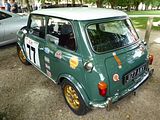
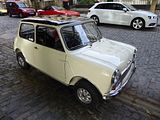
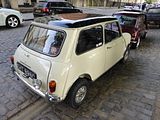
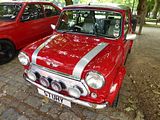
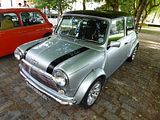
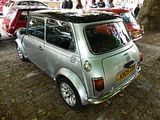
Also to be seen were a couple of non-Cooper models from the era. One of them was the regular model that sat at the bottom of the range in 1990, whilst the other was a Limited Edition 30 car. Produced in 1989 to mark the 30th anniversary of the model, it was based on the Mini Mayfair, with the standard 998 cc engine. 3000 of the cars were made for the UK, 2000 of which were painted in this rich colour called Cherry Red, whilst the remaining 1000 were Black. Exterior trim included chrome bumpers and grille, coachlines and a special 1959-1989 crest on each rear wing, whilst inside there was half leather/lightning cloth with , red piping. Equipment included Minilite-style wheels, security coded stereo, leather-bound copy of Rob Golding’s book (“Mini”). All but 200 of the cars had the standard 4 speed manual gearbox.
Final Mini here was a 1275GT. This car was launched in 1969 as a replacement for the Cooper, and had the squarer front end that also featured on the Clubman. Not nearly as quick as a 1275 Mini Cooper S, the 1275GT was still quite lively for the time, achieving 0–60 mph in 12.9 seconds, and the excellent midrange torque offered a 30–50 mph time in top gear of only nine seconds. The bluff front, however, meant that the model struggled to reach 90 mph. It was also .cheaper to buy, run, and insure. It was the first Mini to be equipped with a tachometer. It also featured a standard-fit close-ratio gearbox. the long-nose Clubman and 1275 GT offered better crash safety, were better equipped, and had better under-bonnet access, but they were more expensive and aerodynamically inferior to the original 1959 design, and they were the first models to be deleted when the new hatchback Austin Metro arrived in 1980, while production of the original “round-front” Mini design continued for another 20 years. At the end of Clubman and 1275 GT production, 275,583 Clubman saloons, 197,606 Clubman Estates and 110,673 1275 GTs had been made. Surprisingly few of them have survived, though.
MITSUBISHI
Another real rarity of the day, also from Japan, was this Colt Galant GTO. Say “GTO” and most people would probably think of the Ferrari 250GTO, but go back to the 1970s and Mitsubishi used these iconic three letters on a sporty Coupe model that they produced as the top model in their range. First shown as the Galant GTX-1 show car at the 1969 Tokyo Motor Show. Sales began in November 1970, when it was the flagship hardtop variant of Mitsubishi’s then new Colt Galant sedan. The Colt Galant GTO exterior was penned by Hiroaki Kamisago, who had previously been sent by Mitsubishi to study at the Art Center College of Design, then located in Los Angeles, California, incorporating a number of stylistic cues from contemporary American muscle cars like the Mustang, Firebird and Cougar, including a long bonnet, raised cut-off ducktail rear, and rounded quad-headlamps and tail-lamps. The GTO was Mitsubishi’s second production car to have full, roll down, side windows and a pillarless design and after the Toyota T40 series Corona of 1966 and Mitsubishi’s own Galant Hardtop launched earlier in 1970; the GTO was the third such Japanese car. Mitsubishi Racing Development (aka Colt Speed) intended the Colt Galant GTO to compete in the prestigious JCCA Grand Prix circuit. However, the OPEC oil embargo of 1973 sounded the demise of GP racing, so the GTO race program was mothballed. Nevertheless, GTOs were successful in rallying, including the famous Japanese Alpine Rally. Mitsubishi chose not to aggressively export the Colt Galant GTO. Besides the home market of Japan, few examples (all right hand drive) were sold abroad. Most of the export cars were distributed to New Zealand, and smaller numbers ended up in various Asian countries, but a small number were sold new in the UK. At the time, Mitsubishi rarely used their own brand name abroad, so many were sold simply as the “Colt Galant GTO”. In Japan, the few remaining good examples and starting to reach “collector” money status, recent examples at auction have commanded over 900,000 JPY. This one would appear to be a Japanese import rather than one of those original UK market cars, Still nice, though.
MORRIS
That evergreen classic, the Morris Minor, was represented by both a Traveller and a Tourer.
This 1929 Cowley is a regular at the event.
NISSAN
It has long been the case that only a subset of the vast ranges of cars that the Japanese marques offer on the home market are sold outside Japan, so there are plenty of model names and designs that are far from familiar. There was a period a few years ago, when quite a lot of these obscure cars came to the UK under a grey import program, as it was cost effective to bring them to the UK, where the fact that they had right hand drive was a decided advantage. A few changes were required to get these cars so they could be road registered, such as the installation of a rear fog light, and most of them are easy to tell – even if the model was actually sold in the UK – as they have a square recess at the back for a Japanese shaped number plate. One of the cars that appeared this way in sufficient quantity that it is reasonably well known is the Nissan Stagea. There have been three distinct generations of the model and this one is an example of the first kind, the WC34 Series, which was sold from 1996 to late 1998 This model bears many visual similarities to the HR31 Skyline, mainly at the front of the vehicle with the headlights and grille being the same shape if only slightly larger, as well as the placement of the air dams and indicator lights being in a similar position, giving the impression of lineage to the Skyline, though mechanically it is most similar to the R33 Skyline. The Stagea was available with a 2.0 single cam, a 2.5 twin cam naturally aspirated, a 2.5 twin cam turbo or 2.6 twin cam, twin turbo engine. All engines were from the RB range, with the 2.6, the 260RS model, being the same as that equipped in the Nissan R33 GTR. Engine power ranged from 153 hp in the 2.0 to 231 hp in the 2.5 turbo and 276 hp in the 2.6 twin turbo. The Stagea was available in 2WD (RWD) and AWD variants, with the RWD variants using RWD Laurel front suspension and AWD versions using RWD R34 Skyline front suspension. Both the RWD and AWD models shared a chassis platform with the C35 Laurel, which had the same wheelbase of 2720mm, and was also available in RWD and AWD. The chassis between 2WD and AWD did have some differences, the main being the drivers side chassis rail on the AWD version being positioned closer to the lower sill. This was done to make room for the transfer case located on the end of the AWD transmission. The AWD system, ATTESA E-TS, is identical in operation to the Nissan Skyline GTS-FOUR and GTR AWD system. As an added extra, the AWD Stageas fitted with an automatic transmission also featured a transfer case lock, this locked the transfer case in full 4wd and bypassed the ABS, g-force sensor inputs and ATTESA E-TS ecu which were all normally required for the AWD system to work. Unlike the Skyline and Laurel which had 5 speed automatic transmissions on some automatic 2.5 non turbo versions, all automatic Stageas were 4 speed. All manual models were 5 speed although only 2 models were available as a manual, the turbo RS4 and the 260RS, which was exclusively manual.
Nissans which have been sold brand new on the UK market, and more recently that, were this duo of Nismo cars: a Juke Nismo and a 370Z Nismo
OPEL
Four Opels, all of them cars which appear quite regularly at this event. Two of them were Manta models from the 1980s. This car lived on after the launch of the front wheel drive Ascona (and near-identical Vauxhall Cavalier), Indeed, a facelift applied in 1982 gave the car a new lease of life, and with the fuel injected1800cc Family 2 engine under the bonnet, and a five speed gearbox, the GT/E version proved quite popular during the early 1980s. Announced in 1986, though it was 1987 before the car made it to the UK, the last Manta B model was called the Exclusive, and it came with all of the best in equipment. Recaro seats with red cloth, grey leather like interior and the full bodypack known from the i200 models. This consisted of twin round headlights in a plastic cover, front spoiler and rear lower spoiler from Irmscher, sideskirts and the known 3 split rear spoiler of the Manta 400 (producing 80 kg (176 lb) of weight on the rear at 200 km/h). In the UK, the Exclusive GT/E models were available in colours such as Dolphin Grey with matching dark grey cloth seats with red piping. These also had the quad headlights, front spoiler but a rear bumper which housed the number plate, coupled with a black plastic strip between the rear light clusters. The rear spoiler was similar to the standard GT/E. Opel finally ceased the production of the Manta B in 1988, only producing the GSi Exclusive during the last 2 years, though sales continued in 1989 until the Manta was replaced by the Calibra. Seen here were a regular GT/E and one of those Exclusive models.
Also on display was the close relative of the Manta, the Ascona 2.0 Berlina. A conventional, family-sized saloon, this body shape is better known in the UK as being that of the first Vauxhall Cavalier, a car which would outsell the model which begat it in the UK by a massive volume. The two were sold, by competing dealers, throughout the life of the model, 1975 to 1981, and there are remarkably few of either left now.
Final Opel was a nice example of the big Monza, a large luxury sports coupe which was based on the Senator saloon, but with neat fastback styling. Sadly, sales volumes were such that Opel did not feel justified in replacing the car with another model.
PEUGEOT
The CJ was the lesser of the two convertible 205 models that Peugeot offered in the second half of the 1980s, having a 1.4 litre carb engine under the bonnet and less in the way of trim and equipment than the CTi model that you more often see.
PORSCHE
There are always plenty of 911s at this event, and this occasion was no exception, with examples of all the different body styles from the 1970s models, through a 964 Carrera 2, a 993, a 997and the very latest 991 Carrera GTS
There were two examples of the 928 here as well, an early car and one of the last, late model GT cars
Other Porsche included a 968 and a very nice replica 550RS Spyder, which had the unmistakeable sound of a VW Beetle when I heard the engine fired up.
RELIANT
Two very different cars bearing the Reliant badge were here, showing the almost Jekyll and Hyde like nature of the Tamworth firm’s product offerings. Of the two, it is the late model Robin Estate which is the better known, as these three wheeler gained a notoriety almost from birth, which they never shook off (and probably quite deservedly so, too, even if they are not as unstable as the Top Gear feature would like us all to think). A Reliant of a very different sort was this Scimitar GT Coupe, the precursor to the better known GTE Sports-Hatch that achieved a certain amount of fame, helped by the enthusiasm for the model displayed by once Princess Anne who had several of them.
RENAULT
I’ve seen this R5 Monaco at the event before, and knew that it tends not to linger long, so I made sure that I got some pictures before it made yet another early departure. The Monaco was a luxurious top of the range addition to the “supercinq” range, added in 1987, and featuring the 1721cc engine under the bonnet and a lot of leather trim. It was costly for a small car, so not surprisingly, few were sold.
Renault really hit the bulls eye with the sporting versions of the second generation Clio, creating a class-leading hot hatch which was good in initial 172 guise and better still in the facelifted 182 versions. Not content with the basic car, RenaultSport offered a number of versions, and the last one is widely seen by enthusiasts to be best. Called the Trophy, 550 were made worldwide. They were based on Cup models and included suspension revisions such as Sachs remote-reservoir dampers and Eibach springs on the front, which lowered the front ride height by 10mm, and revised dampers on the rear, lightweight Speedline Turini 16″ Anthracite wheels, spoiler from the Clio 255 V6, RecaroTrendline seats and exclusive Capsicum red paint with Trophy decals on the sills and an individually numbered plaque on the driver’s seat base. 500 went to the UK, while a further 50 (with subtle differences) went to Switzerland. None were ordered by the Marketing Department of Renault France, mistakenly believing there was no market for this type of extreme hot hatch. The Trophy has been heralded as one of the best hot hatches of all time and won ‘Evo’ magazine’s People’s Performance Car of The Year, 2005, whilst also beating rivals such as the Lamborghini Gallardo and other exotica in a group test. Autocar magazine’s front cover of 5th July 2005 simply summed up their review with the headline “World’s Greatest Hot Hatch”.
SMART
This was just the sort of day to enjoy this 2002 Smart Crossblade, a limited edition variant of the City-Cabrio, as the first cars were called before the ForTwo branding was coined, a roadster without a windshield, roof or conventional doors. Its weight was still 740 kilograms (1,630 lb). The Brabus-tuned engine developed 71 PS from its 599 cc engine. Robbie Williams purchased Crossblade number 008, and Smart then began a marketing association with him, using him to promote the brand and the new Forfour.
Also to be seen was one of the short-lived Roadster models.
SUBARU
Reminder yet again, should one be needed, how the Subaru has faded more than somewhat from the affections of the enthusiast. A few years ago, an event like this would have been packed out with the marque, mostly Impreza models, as these were among the best value performance models available, but those days have long since passed as Subaru now makes little more than a series of insipid AWD machines which have little appeal to anyone apart from Americans in the snow-belt States who like the idea of continued mobility in harsh weather. So, only sone Subaru in this event, but it was a rather special car, one of the limited edition 22B machines built as a rally homologation special.
TALBOT
There were two examples of the Sunbeam Lotus. These are about the only versions you see nowadays of the small hatchback produced in something of a hurry. on a low budget, as a much-needed replacement for the long-running Imp, and intended to compete with the Fiesta, VW Polo, Fiat 127 and Renault R5 which were achieving big sales in a growing sector. Although quite neatly styled, the Sunbeam was based on a cut-down version of the Avenger, which meant that unlike its rivals, it came with rear wheel drive. Not great for space efficiency, but it did not take long for the bosses at Chrysler to realise that this gave them some different possibilities: motorsport. The first potent Sunbeam to appear was the Ti, a sort of modern day version of the Avenger Tiger, with a 110 bhp twin carb 1600cc engine under the bonnet. It went on sale in the spring of 1979, as an appetiser for something more special, which was unveiled at the Geneva Show in March 1979, when it became apparent that Chrysler had commissioned the sports car manufacturer and engineering company Lotus to develop a strict rally version of the Sunbeam. The resulting ‘”Sunbeam Lotus” was based on the Sunbeam 1.6 GLS, but fitted with stiffer suspension, a larger anti-roll bar and a larger transmission tunnel. The drivetrain comprised an enlarged 2172 cc version of the Lotus 1973 cc 907 engine, a 16 valve slant four engine (the Sunbeam version being type 911, similar to the “Lotus 912”), along with a ZF gearbox, both mounted in the car at Ludham Airfield, close to the Lotus facility in Hethel, Norfolk, where the almost-complete cars were shipped from Linwood. Final inspection, in turn, took place in Stoke, Coventry.In road trim, the Lotus type 911 engine produced 150 bhp at 5,750rpm and 150 lb/ft of torque at 4,500rpm. In rallying trim this was increased to 250 bhp Production cars were not actually ready for deliveries to the public until after the mid-year rebranding, and thus became the “Talbot Sunbeam Lotus”. At first these were produced mostly in black and silver, although later models came in a moonstone blue and silver (or black) scheme. The car saw not only enthusiastic press reviews, but also much success in the World Rally Championship – in 1980, Henri Toivonen won the 29th Lombard RAC Rally in one, and, in 1981, the Sunbeam Lotus brought the entire manufacturer’s championship to Talbot.
TESLA
The Model S is starting to become a reasonably common sight on our roads. Proof not just that this is a car that Californians will buy, but that given enough range, electric cars are indeed a viable proposition for more than the tiny minority. I am sure that when the next couple of models – a 3 series rival and an SUV – are added to the range, sales will increase still further.
TOYOTA
Another grey market import, the Trueno was one of the badged used by Toyota in Japan for cars that we knew as the Corolla, and few have had the enduring appeal like this one, an AE86 Coupe. This is the car which was the inspiration for the current GT86 car, and whilst we saw the Corolla version, in the mid 1980s, as a hatchback coupe, this one shows that other bodystyles were available as well.
I saw this bright yellow Supra parked up and formed a mental image of the sort of person who might be driving it. How wrong could I be, as later in the morning, I saw the car pull away! This was more or less the apogee of the Japanese muscle car in the mid 1990s before the massive hike in insurance premiums brought this part of the market to a premature and abrupt end.
TRIUMPH
There were a couple of the large Triumph saloons here, but somehow, both eluded my camera, but two of my favourite models from this sadly extinct marque did not, a TR6 in the fitting colour of Mimosa and a Stag
TROJAN
The tiny little Trojan always attracts a crowd, with many intrigued by the car, especially when they see the whole front open and how you have to launch yourself in (carefully!). Trojan had a long history producing cars and trucks, and this was the last model produced to bear their name, but it was not their design. In fact it was a German Heinkel built under licence at the Croydon works between 1960 and 1965. The original Heinkel Kabine was a microcar designed by Heinkel Flugzeugwerke and built by them from 1956 to 1958. The Kabine Model 150, used a 174 cc 9.2 hp single-cylinder four-stroke engine that powered the Heinkel Tourist scooter. Later that year, Heinkel introduced the Kabine Model 153 (with three wheels) and the Kabine Model 154 (with four wheels), both with 204 cc engines. The engines in these models were later reduced in capacity to 198 cc for insurance purposes. The Kabine had a steel unit body. Access to the interior was by an opening front, but in order not to infringe Iso Rivolta’s patent used on the Isetta, the steering wheel did not move with the door. However, it did feature a reverse gear, unlike some other bubble cars. The fabric sun roof served as an emergency escape hatch should the sole door in front become jammed in a collision. Production was transferred under licence to Dundalk Engineering Company in Ireland in 1958 but the licence was withdrawn shortly afterwards due to poor quality control. Production restarted in 1960, again under licence, under the Trojan 200 name by Trojan Cars Ltd. in the UK, and continued until 1966, and the car was also assembled from 1959 to 1962 under licence by Los Cedros S.A. in Argentina, alongside Studebaker pickups.
TVR
There are usually a good number of TVRs at this event, and this month was no exception, with a Griffith, a couple of Chimaeras, a Cerbera and a Tamora from the most prolific period in the Blackpool company’s output joined by an earlier 350i and a pair of the S models, one with Ford V6 power and one the more potent Rover V8.
VAUXHALL
Oldest Vauxhall seen here was an HC Viva. The third generation of the car to bear the name, this was lived longer than the other two put together, being produced from 1970 to 1979. Although it sold in decent numbers, it always stayed in the shadows compared to the Ford Escort, its principal rival, and far fewer of them have survived, so, although this car does not look completely as it would have done when leaving Ellesmere Port, it was still nice to see it.
When Vauxhall created the Saloon version of the first Astra, they kept the same profile as was used for the Hatch models, and simply fixed the rear window in place, leaving a conventional boot lid. I’m not sure that I really see the point, but the Saloon models were a little cheaper than the Hatch cars, and early Astras were relatively expensive compared to their competitors. Few have survived, so it was good to see this one.
There was also a second generation Astra here. This was one of the Cabrio models that was added to the range after Opel/Vauxhall had realised that there was demand not just for the Golf Cabrio, but the Escort and the Ritmo/Strada, so they needed an open topped model as well. The pale lilac colour is a genuine period offering.
GM were late to the front wheel drive supermini party, citing a lack of European manufacturing capacity as one of the reasons why they had no answer to the Fiesta, Polo, R5 and Fiat 127. The Opel Corsa and Vauxhall Nova were finally launched in October 1982, made in a brand new plant in Zaragoza in Spain. One advantage of being late to the class, was that the cars were noticeably more modern than their rivals, with overhead cam engines and five speed gearboxes available in the top spec cars, something no-one else had at the time (though they caught up within months). Top of the range was the SR, a sporty model with only different gearing to alter the performance, as well as sports suspension, seats and trim, which made it decent to drive, if you could cope with the offset driving position. The car had a long production run, not being replaced until after its 10th birthday. The last couple of years saw the 1300cc engine upgraded to a 1.4, partly to offset the power losses from the mandated catalytic converter that was fitted.
Also present was a bright orange VX220, a car which is often to be seen at this event. Although it looks quite different, the VX220 and its Opel Speedster alter ego share much under the skin with the Lotus Elise, and indeed the cars were built for General Motors, by Lotus at Hethel. Quite unlike any Vauxhall that had ever come before it, the VX220 was the result of a deal between GM and Lotus, struck to generate enough funding for the latter to be able to develop a replacement for their Elise model, something forced on them owing to changes in European crash safety regulations for the 2000 model year. Lotus agreed to develop and produce a 2 seater sports car for GM, on the new Series 2 Elise chassis, with the a concept version of the proposed GM model being shown at the Geneva Motor Show in 1999. Although the body styling was different, clearly the economies would only work if as much else could be shared, and that presented a challenge as it was planned to use a 1.8-litre Toyota engine, similar to that found in the Toyota Celica, in the second generation Elise, whereas the GM cars clearly had to use a GM engine, namely the 2.2-litre GM Ecotec engine from the Astra. As neither engine had been used in the original Elise, which had been fitted with a 1.8-litre Rover K-Series engine, this simply became one of the many design challenges .In order to accommodate the production of the new cars, Lotus expanded its Hethel factory to a capacity of 10,000 cars, with around 3,500 slots allocated to Speedster production. Production of the Speedster commenced in 2000. The car was hailed by the motoring press as a great drivers’ car and won several accolades, including Top Gear’s Car of the Year in 2003. The lesser naturally aspirated 2.2 version was considered easier to drive than the potent Turbo model, and some journalists suggested that the Opel/Vauxhall car was better value for money than the Lotus, among them one Jeremy Clarkson in his 2003 DVD Shoot Out. However, the market did not really agree, and sales were limited. The car was deleted in 2005, with no successor.
VOLKSWAGEN
Golfs were represented by either end of the 7 generations that have been produced in the last 41 years. There were three examples of the legendary GTi Mark 1 and there was also a very nice brand new Golf R
As well as nice “Bus” version of the Type 2, there was an example of what seems to the latest craze, a very slammed and very weathered look Van.
Also representing the Wolfsburg marque were a couple of classic Beetle 1200 models.
WILLYS
Some months see quite a number of military vehicles attending, but this time there was just the one, a 1941 Willys Jeep.
This was definitely worth the short trip from home, before returning back for a weekend of doing very little. The next Breakfast Club is scheduled for Sunday 13th September, but as this is also the date of the Bristol Half Marathon, and the Square and access to it will be closed off all morning, it is currently unclear whether there will be a September meeting, and if so when and where. My diary is sufficiently full that will be December before I can attend the next one, anyway, but that should not stop anyone else from experiencing this friendly and diverting way to spend a Sunday morning.

